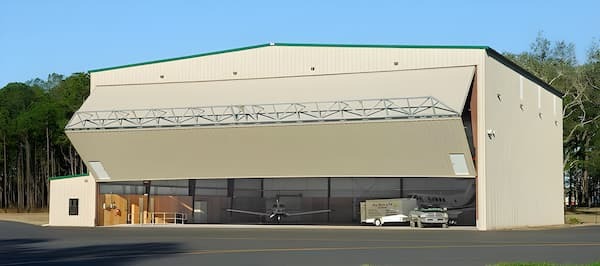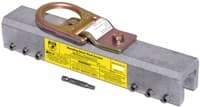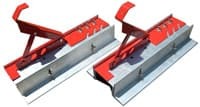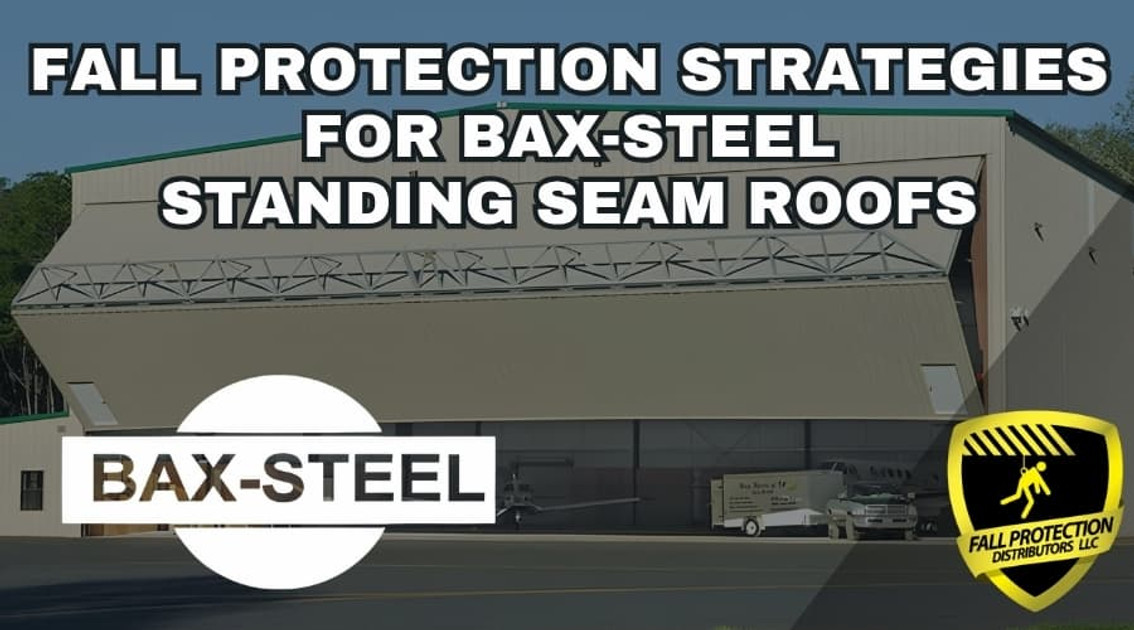Fall Protection Solutions for BAX-Steel Standing Seam Panels
Posted by Howie Scarboro - CEO Fall Protection Distributors, LLC on Nov 3rd 2025
See the Roof Anchor Compatibility Chart for BAX-STEEL Standing Seam Panels.

Who Is Bax-Steel?
Bax-Steel has been shaping the metal building industry in Baxley, Georgia, since 1959.
It all started with two craftsmen and a welding torch. In 1959, a small steel fabrication shop opened its doors in Baxley, Georgia, specializing in sturdy frames for local projects. That small beginning grew into one of the South's most respected names in pre-engineered metal buildings. Six decades later, Bax-Steel still stands for the same principles of hard work, honest craftsmanship, and a commitment to lasting relationships.
Bax-Steel manufactures steel buildings for nearly every purpose imaginable. From aircraft hangars and manufacturing plants to barns, warehouses, and retail centers, each project begins with a blank canvas. The company's design teams work with clients to customize every detail, from dimensions and eave height to insulation and ventilation. Every building meets local codes, protects valuable equipment or inventory, and stands firm against the Southern elements.
Their use of Galvalume steel adds another layer of protection, resisting corrosion and fire while maintaining a clean, professional appearance for decades. Whether you need a wide-open hangar, a climate-controlled warehouse, or a rugged agricultural facility, Bax-Steel delivers solutions that balance function and aesthetics.
Among their many roof systems, the Bax-Lock standing seam panel stands out as a flagship choice. It combines architectural appeal with the structural strength for which Bax-Steel is known, creating a weather-tight, visually refined roof that fits a wide range of applications.

Why Are Non-Penetrating Fall Protection Anchors Critical for Bax-Steel Roofs?
Penetrating a Bax-Lock roof panel with fasteners can void warranties and break the weather-tight seal.
Bax-Steel's Bax-Lock panel system provides long-term performance without through-fasteners. Its clean seams and concealed clips allow the roof to expand and contract with temperature changes while keeping water out. The moment someone drives a screw or bolt through that surface, the system loses its protection. Even one misplaced fastener can lead to corrosion, leaks, or insulation damage, and it can easily void the manufacturer's warranty.
That is why non-penetrating fall protection anchors are the right choice for Bax-Lock roofs. These systems protect both the roof and the worker by clamping directly onto the seams or over the ridge without drilling. Choosing non-penetrating anchors isn't just about safety; it's about preserving the long-term value of every Bax-Steel building. These systems protect the warranty, the structure, and the reputation of the craftsmen who built it.
Bax-Lock Mechanical Standing Seam Panels

Bax-Lock panels combine exceptional strength with a weather-tight design that protects both structure and style.
The Bax-Lock mechanical standing seam panel is one of Bax-Steel's most trusted roof systems. Built for long-term performance, it offers the rugged durability needed for industrial, commercial, and architectural projects where reliability is non-negotiable. These panels are manufactured from high-strength 22-gauge or 24-gauge Galvalume steel, providing a solid foundation for any building that demands strength, longevity, and weather resistance. See the Roof Anchor Compatibility Chart for BAX-STEEL Bax-Lock Standing Seam Panels.
Each panel spans 24 inches in width with a 3-inch-tall trapezoidal seam. This configuration delivers structural stability across long runs. It allows installation on roof slopes as low as 1:12, giving designers greater flexibility in low-slope applications. The mechanical seam design locks together for a continuous, weather-tight seal that resists water intrusion even under heavy rainfall. Hidden clips and fasteners maintain the roof's clean appearance while accommodating thermal expansion and contraction.
Bax-Lock's design is equally at home on extensive manufacturing facilities, aircraft hangars, or retail centers. The panels handle demanding environments with ease, maintaining their structural integrity under wind loads and temperature swings. The result is a roof system that looks sharp, performs flawlessly, and protects what's underneath for decades.
Fall Protection for Bax-Lock Standing Seam Panels
Seam-mounted anchors protect Bax-Lock panels without drilling, preserving their weather-tight design while keeping workers safe.
Working safely on Bax-Lock panels requires fall protection that complements their non-penetrating construction. Traditional screw-down anchors can damage the roof, break the seam seal, and void warranties. That's why seam-mounted, non-penetrating anchors are the gold standard for Bax-Lock roofs. They protect both workers and the roof system simultaneously.
The Standing Seam Roof Anchor (SSRA1) is the core of this safety system. It clamps directly onto the Bax-Lock seams using non-penetrating set screws that create a powerful grip without piercing the metal. This anchor provides a 5,000-pound-rated connection point that meets or exceeds OSHA and ANSI standards. Once installed, the SSRA1 becomes a solid tie-off point for a single worker, maintaining complete roof integrity while offering total confidence in safety.
To expand versatility, the SSRA2 Adjustable Roof Jack Adapter mounts directly to the SSRA1 Anchors. This combination allows contractors to support 10-foot walkboards between anchors, creating stable, non-penetrating work platforms. The height can be adjusted to match different seam profiles, providing roofers with a secure, level surface to work from without compromising panel seams.
For larger projects or team operations, the SSRA3 Anchor Plate further enhances the system. It connects across two SSRA1 Anchors, forming a mounting platform for a temporary horizontal lifeline. When paired with the Malta Dynamics HLL3001 100-foot Horizontal Lifeline Kit, the SSRA HLL setup provides two workers with continuous mobility along the roofline while maintaining compliance with OSHA 1926.502 and ANSI Z359.18 standards. The system distributes loads evenly across the seams, protecting the panel finish and preventing structural damage. When a more permanent solution is required, the Super Anchor 120-foot Permanent Horizontal Lifeline includes everything needed for a durable, lasting HLL assembly. This permanent kit saves workers time on roofs that require regular maintenance access.
For steep Bax-Lock roofs with a pitch of 6:12 to 12:12, the Ridge Pro Steep Assist Anchor is the preferred choice. It hooks securely over the roof ridge and allows a vertical lifeline to be connected before the worker ever steps onto the roof surface. This design keeps workers 100 percent tied off from ladder to ridge and back again while eliminating the need for penetrations or mechanical fasteners. Each of these products works together to create a complete, non-penetrating fall protection system tailored to Bax-Lock's unique panel design. Together, they safeguard workers at height while preserving the warranty, finish, and weather-tight seal that make Bax-Steel roofs stand out in the industry.
Standing Seam Metal Roof Anchor Panel Compatibility Chart For BAX-STEEL
| Bax-Lock 22 Gauge Panel | Bax-Lock 24 Gauge Panel | |
|---|---|---|
SSRA 1 |
YES | NO |
SSRA1 Nylon Tip |
YES | YES |
SSRA2 Roof Jack |
YES | YES |
SSRA3 Anchor Plate |
YES | YES |
The Ridge Pro |
YES | YES |
Contact Us For Fall Protection On Standing Seam Roofs
For further details on roofing solutions and fall protection systems, contact us at 863-703-4522 or www.StandingSeamRoofAnchor.com. Let's work together to make your roofing projects safe, beautiful, and built to last. For more safety tips, refer to OSHA's 48-page Fall Protection Manual. Once you have determined the most suitable anchors for your roof system, download our free Anchor Inspection Form.
Safety Tips For Standing Seam Roofs
Ensure Proper Footwear for Stability
A roofer's footing is their foundation. Durable, slip-resistant boots give you traction where it matters most on smooth metal panels and steep inclines. Quality roofing footwear also provides ankle support, reducing fatigue during long hours on the roof. Dust, dew, or heat can change footing fast, but well-made boots help maintain balance and confidence all day.
Develop OSHA Compliant Safety Plans
Every safe project begins with a written plan. Crews need clear guidance on tie-off locations, rescue strategies, and individual responsibilities before the first ladder goes up. This preparation removes confusion and builds consistency across the team. When accidents occur, a solid safety plan becomes the roadmap that keeps everyone on track and reduces rescue times.
Install Permanent Roof Anchor Systems
Buildings that require ongoing roof access benefit from permanent anchors that stay in place year-round. Once installed, they eliminate guesswork about where to tie off, ensuring workers always have a secure connection point. Permanent systems maintain the roof's appearance and integrity while offering lasting OSHA-compliant safety for maintenance crews and contractors alike.
Use Specialized Anchor Systems for Standing Seam Roofs
Standing seam roofs demand anchors that grip seams without damaging them. Non-penetrating systems such as seam-mounted anchors clamp securely to the ribs, creating reliable tie-off points while preserving the roof's weather-tight seal. The correct anchor choice prevents leaks, protects warranties, and ensures compliance with fall protection standards on every project. Try to avoid seam anchors that require mounting on top of the hidden clips under the panels; these clips are nearly impossible to locate on existing roofs.
Encourage the Use of Trauma Straps
When a fall leaves a worker hanging in their harness, trauma straps can completely change the outcome. These small but vital straps allow the user to press their legs downward and keep blood flowing while waiting for rescue. They're simple, lightweight, and easy to attach to any harness, turning a few minutes of waiting into a survivable event.
Prioritize Ladder Safety Training
Safe ladder use begins with inspection and setup. Workers should check for damage, set ladders on stable surfaces, and follow the four-to-one rule for angle and height. Keeping three points of contact and using tool belts or lifts instead of carrying materials by hand can prevent the majority of falls. Consistent training keeps these habits sharp and automatic.
Promote a Culture of Safety
When crews take time to talk about potential hazards before work begins, safety stops being a rule and becomes a habit. Morning huddles, jobsite check-ins, and post-shift reviews all reinforce awareness. Over time, communication builds trust, and trust builds a team that watches out for one another.
Set Up Protective Guardrail Barriers for Work Zones
Properly placed guardrails define safe zones near edges, skylights, and openings. They protect without getting in the way, allowing workers to focus on the job instead of the risk. When installed at the start of a project, guardrails eliminate the need for constant reminders about where danger begins. They're a simple, reliable layer of protection that never stops.
Consult Experts for Curved Metal Panels
Radius and arched panels present unique challenges that standard anchors may not solve. Before starting work, have a fall protection professional inspect the structure and determine the safest tie-off method. A quick evaluation up front can prevent expensive damage and unsafe conditions later.
Equip Workers with High Quality Safety Gear
A safety harness or lanyard is only effective when it's comfortable enough to wear correctly. Workers should inspect every buckle, strap, and connector before climbing. OSHA's recent updates highlight the importance of gear sizing, reminding every employer that safety starts with equipment that fits the worker, not the other way around.
Disclaimer
The views, recommendations, and information presented in this blog are solely those of the author and do not necessarily reflect the opinions or positions of the featured panel manufacturer, its brands, subsidiaries, or parent companies. Customers are strongly encouraged to contact the roof panel manufacturer directly for inquiries regarding fall protection compatibility with their products and to address any potential warranty issues that may arise after installing our products.

